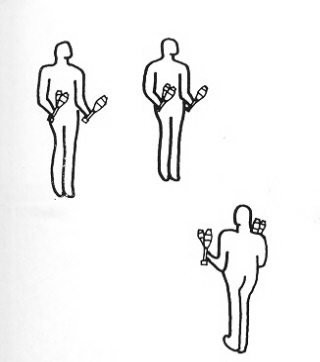
10 Club Feed |
13-Club Feed |
Page 35 Fall 1989
|
Ten-Club
Feed For
good practice toward passing seven clubs, take a feedee position in
the ten-club feed. The feedees are essentially passing seven clubs,
but they only have to pass every other (a 4-ct). The feeder starts with
four clubs and the feedees three clubs each, and all passes are
doubles.
The
feeder starts first and simply alternates
throwing doubles to the two feedees (starting, say, by passing to
the left feedee). Each feedee starts by passing a double, one count
after being thrown the first pass - the same start delay as when
passing seven clubs. Continue by passing every other club. One common problem in this feed occurs if the passes from the right feedee are short or low. That's because the feeder has to throw under those passes to get to the left feedee (left and right are from the feeder's perspective). So the right feedee should be sure to throw high and long enough to avoid this problem. It's also important to throw decent doubles of course.
Trick throws can be added, such as flats (easy), chops (harder) and under the leg doubles. These throws should be high enough so that they take the same amount of time to land as a double would. Higher throws such as early or late triples or quads can be made to fit in quite naturally. Try a triple-quad from the feeder, or continuous triples from both feedees.
To
make the pattern more challenging, a trio of experienced passers
should try it with singles instead of doubles. The same problem with
the right feedee's passes occurs here, but with even less room for
error.
Although
the feeder usually starts with the extra club, someone else often
has four clubs after some dropped clubs have been picked up. See if
you can figure out how to start the ten-club feed if one of the
feedees has the extra club. 13-Club
Feed Of course we can add more feedees to a ten-club feed. With three feedees, we get a 13-club feed, and the feeder has to learn to catch a club coming from a feedee two positions behind where the next pass goes. This can be a little confusing at first, but it's fun when you get in the habit of just catching whatever club shows up near your catching hand.. You don't have to figure out where it came from. Maybe try a 13-club feed with singles.
Random
13-Club Feed Now
comes the fun when we make the 13-club feed random and thus
require strict attention by the feedees, because no one knows what
the feeder will do next.
In
a normal 13-club feed, the feeder goes down the line and back
continually. Each feedee passes back to the feeder one count after
a pass from the feeder. In
the random feed, the feeder is allowed at each passing beat to
pass to any of the feedees. Whoever the feeder passes to has to
respond with a return pass. Because there is one count between the
feeder's pass and the resulting feedee' s pass, it's not hard to
respond in time. The feed can move down the line normally or it
can jump around. The feeder can even throw in an occasional self
triple without disturbing the juggling pattern.
In
order to be ready to respond, each feedee should keep an eye on
the feeder's passing hand (or body in general) to figure out when
a pass will be coming. For starters, it's easier if the feeder
doesn't throw two or more passes in a row to the same person, but
even that can be handled with some practice.
In
Conclusion... Do
you have another passing pattern involving throws to random people,
such as the random feed above? If so, tell us how it works.
A regular part of Juggler's Workshop will be a pictorial description of a juggling move. This time we have peel offs, which have a pleasing visual effect but which aren't difficult provided you can balance a club with either hand.
|

10 Club Feed |
13-Club Feed |

Start with one club balanced as shown. Allow the club to begin to fall (peel off) to the right. |

Raise the club in your right hand to balance it on the club in your left. The other club is still touching but is falling. |

Maintain the balance with your left hand and catch the falling club in your right. Now let the balanced club "peel off" to the left and repeat the whole series to reverse. Continue for as long as you like. |